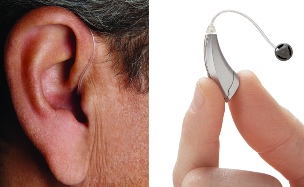Hearing Evaluations and Fittings
It is important to bring someone with you to this appointment since there is a lot of information given and important decisions to make. After talking with you, your audiologist will determine which type of hearing aid will best fit your particular needs. The three biggest factors will be (1) type and degree of hearing loss, (2) your lifestyle, and (3) your budget. It is important to note that hearing aids are rarely covered by insurance.
Our highly-trained staff will use the information obtained in the audiological evaluation as well as your specific case history to help narrow the choices of hearing aid types and styles. The final decision on which hearing aid is purchased is the choice of the wearer. We respect our patients and will never sell hearing aids to those who do not need them.
Hearing Aid Styles
There are generally two styles of hearing aids: Behind-The-Ear and Custom. Almost any type of hearing loss can be fit with almost any style. The following are the most common types of hearing aids:
1.) Behind-The-Ear Hearing Aids:
Traditional Behind-the-Ear (BTE)
Open Fit BTE
Receiver-in-the-Canal (RIC)
2.) In-The-Ear (Custom) Hearing Aids:
In-the-Ear (ITE)
In-the-Canal (ITC)
Completely-in-the-Canal (CIC)
Invisible-in-the-Canal (IIC)

Traditional Behind-the-Ear (BTE)
Consists of a hard plastic case worn behind the ear which is connected to a plastic ear mold that fits inside the outer ear. The electronic parts are held in the case behind the ear. BTE aids are used by people of all ages for mild to profound hearing loss.

Open Fit BTE
Sleeker, open-fit aid that fits behind the ear completely. The narrow tube is connected from the hearing aid case to a small breathable plastic piece, which is inserted into the ear canal. Some people may prefer the open-fit hearing aid because their perception of their voice doesn’t sound “plugged up.” Open Fit BTE aids are used by adults for mild to moderately-severe degree of hearing loss.

Receiver-in-the-Canal (RIC)
Sleeker and smaller because the actual receiver of the hearing aid sits directly inside of the ear canal. A small breathable plastic piece covers the receiver, which sits on the end of the thin wire. RIC aids are used by adults for mild to severe degree of hearing loss depending on the size of the earpiece that sits in the ear canal.

In-the-Ear (ITE)
Fits completely inside the outer ear and is used for mild to severe hearing loss. ITE aids usually are not worn by young children because the casings need to be replaced often as the ear grows or changes in shape, for example, if one gains or loses weight.

In-the-Canal (ITC)
Made to fit the size and shape of a person’s ear canal.

Completely-in-the-Canal (CIC)
Nearly hidden in the ear canal. Not recommended for young children or for people with severe to profound hearing loss because the reduced size limits their amount of power and volume to help the patient hear.

Invisible-in-the-Canal (IIC)
Designed to be completely in the canal and completely hidden from view externally. Not recommended for young children or for people with severe to profound hearing loss because the reduced size limits their amount of power and volume to help the patient hear.